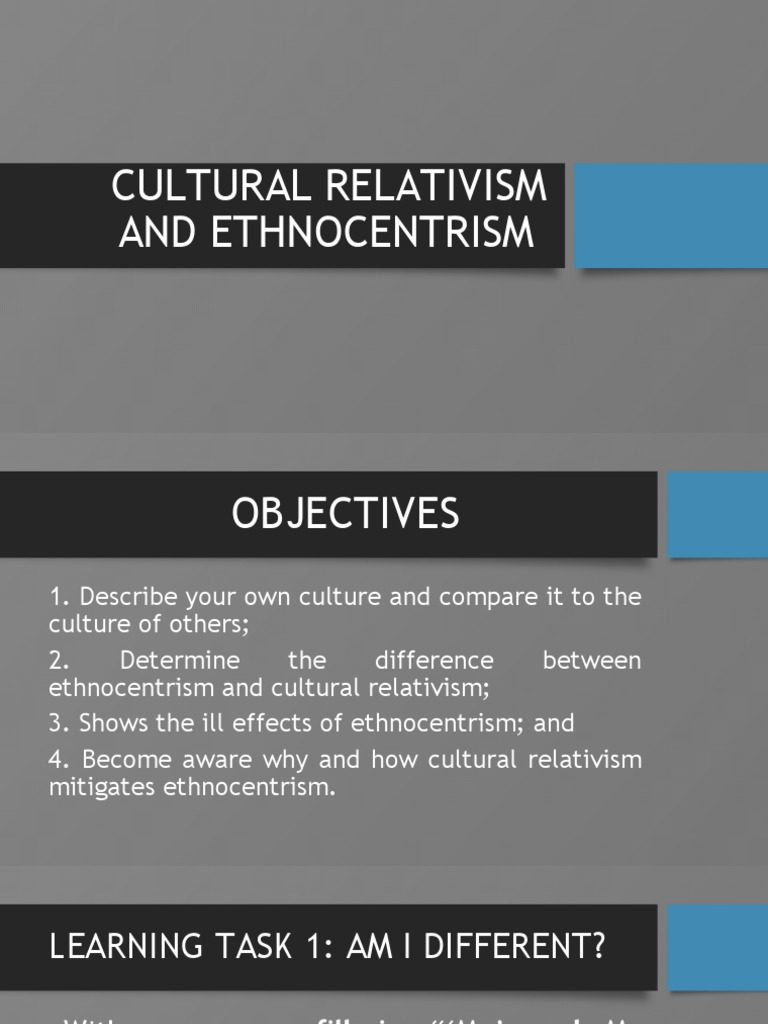The exploration of ethnocentrism and cultural relativism prompts profound contemplation in an increasingly interconnected world. Understanding these two paradigms facilitates a more nuanced perspective on global interactions. Using a Venn diagram to illustrate the relationship between them not only clarifies their distinctions but also highlights their interconnections.
At the outset, it is essential to define ethnocentrism and cultural relativism. Ethnocentrism is the belief that one’s own culture is superior to others. It invariably leads to a biased worldview where individuals evaluate other cultures based through the lens of their own cultural norms and values. This phenomenon can manifest in various dispositions, from unconscious biases to overt displays of prejudice, shaping attitudes towards diversity in society.
In contrast, cultural relativism posits that a culture’s beliefs and practices should be understood based on its own context. Rather than adhering to a hierarchy of cultures, cultural relativism prompts individuals to seek understanding and appreciation of cultural differences. This perspective encourages open-mindedness and fosters an environment of respect amidst diversity.
To visualize the complexities of these concepts, a Venn diagram is particularly effective. One circle represents ethnocentrism, while the other stands for cultural relativism. The intersection, where the two circles overlap, signifies instances where individuals may navigate within both paradigms, often characterized by a spectrum of understanding and misjudgment.
The intersection demonstrates a crucial aspect of human interaction. For example, when individuals encounter unfamiliar customs, their immediate reaction may be one of skepticism or misunderstanding, typical of ethnocentric attitudes. However, through the process of critical reflection and exposure to different cultures, an individual may shift towards cultural relativism. This shift signifies a transformative journey, demonstrating how perspective is malleable and can lead to deeper connections between diverse communities.
One of the pivotal areas of overlap involves cultural assimilation. This phenomenon occurs when individuals adopt elements of another culture, often leading to the diminishment of their original cultural identity. While this can be viewed through an ethnocentric lens as a dilution of cultural integrity, cultural relativism allows for recognition that such exchanges can enrich both individuals and societies. Understanding this complexity fosters a more intricate viewpoint on cultural dynamics.
A significant critique of ethnocentrism is its propensity to perpetuate stereotypes and foster division. Through the lens of ethnocentrism, individuals may create exaggerated or negative assumptions about other cultures, which can incite conflict and misunderstanding. Conversely, cultural relativism emphasizes empathy and strives to dismantle preconceived notions, promoting dialogues that are constructive rather than contentious.
The dialogue becomes particularly relevant in contemporary discourse surrounding globalization. As cultures intermingle, the battle between ethnocentric thinking and cultural relativism intensifies. With global migration and technological advancements, individuals are more frequently exposed to cultural diversity. In such contexts, it becomes increasingly necessary to adopt a cultural relativist perspective to facilitate harmonious coexistence. The Venn diagram serves as a reminder that while ethnocentrism may be an intuitive reflex, there is a potential for evolution towards understanding and acceptance.
On the societal level, the implications of navigating these paradigms extend to educational systems, media representations, and policy-making. In educational contexts, integrating cultural relativism within curricula can cultivate not only comprehensive global awareness but also critical thinking skills among students. Encouraging students to explore various cultures allows them to identify ethnocentric tendencies in themselves and aspire towards a more equitable worldview.
At the same time, media portrayals often oscillate between ethnocentrism and cultural relativism. Responsible media practices have the power to challenge stereotypes and promote authentic cultural representations. This delineation in media narratives is imperative in shaping public opinion and fostering a climate of mutual respect. When individuals consume diverse cultural content, they begin to dismantle the barriers erected by ethnocentrism.
As various stakeholders engage in dialogues about cultural identity, it becomes clear that embracing the overlap between ethnocentrism and cultural relativism is integral in resolving conflicts. Societies that fulfill this approach acknowledge inherent biases and simultaneously challenge them by seeking inclusivity. This constructive engagement holds promise for forging stronger communities, highlighting the importance of interdependence and shared understanding.
Ultimately, while ethnocentrism and cultural relativism initially appear as dichotomous paradigms, the interplay revealed through the Venn diagram presents a richer narrative. It beckons individuals to confront their biases and cultivate openness to new ideas. Embracing cultural relativism does not imply the automatic dismissal of one’s own cultural heritage; instead, it encourages a harmonious coexistence of diverse practices and beliefs. Such a standpoint injects curiosity into our social fabric, fostering a robust dialogue about identity, values, and coexistence.
The promise for a shift in perspective lies in the acknowledgment that every culture has intrinsic value. In a world rife with divisions, cultivating an appreciation for this complexity can inspire transformative change. Such a commitment not only enhances individual experiences but also augments social cohesion, paving the way towards building a more empathetic and interconnected world.
